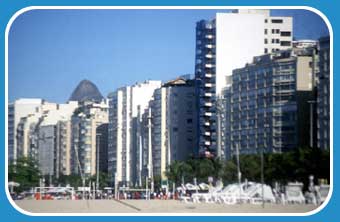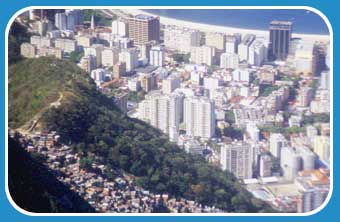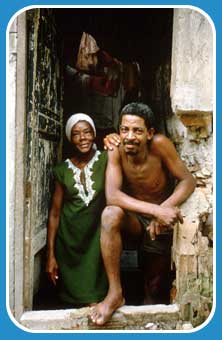| |
Rio de Janeiro has undergone
rapid urban growth over the last forty years. With around
6 million people living in the city itself, Rio today still
ranks as one of the world's largest cities.
A city of contrasts

©Simon Scoones/Worldaware
|
Copacabana
beach |
|
| Some residents of
Rio enjoy extremely high living standards. Owning property
on the Copacabana beachfront can cost millions of pounds.
However, 20% of Rio's population live in the city's 600
favelas.
In the past, favelas
have conjured up images of dirty, dangerous places with
a miserable quality of life, but today, many favela
communities are working in partnership with the Rio city
authorities to counteract these negative images and to
combat poverty. |
The
favelas
are scattered around the city on waste ground or on
one of Rio's many steep ravines where building is difficult.
|

©Simon Scoones/Worldaware
|
 ©Rex Features
©Rex Features
|
Although a favela
resident pays taxes like any other citizen in Rio, many
have felt neglected by the city authorities and their
richer neighbours. To reflect their disillusionment, half
a million people voted for a monkey in one of the elections
for the mayor of Rio during the 1990s. But Rio's residents
have begun to appreciate the positive contribution that
favela dwellers
make to Rio's economy by providing low cost services and
goods in the informal
sector as well as being the birthplace of Brazil's
Samba dance schools and some of the country's greatest
footballers like Pelé, Ronaldo and Rivaldo. |
The 'Favela-Bairio'
programme
Nevertheless, favelas
need support from outside. Since 1995, the Rio city authorities
have invested in the most expensive programme ever to improve
life in the favelas.
With financial backing from the Inter-American Development
Bank, the Rio city authorities have spent $500,000 on the
'Favela-Bairio' programme to improve the services and infrastructure
in 300 of Rio's favelas.
At the same time, the programme promotes self-help amongst
favela residents,
building on the strong community spirit that exists there.
To make the most of the money available, the city authorities
discuss and negotiate with the local community committees
to find the best ways in which local people can help themselves.
Click on the icons for
examples of how the 'Favela Bairio' programme is improving
the quality of life in two favelas.
Drug Wars
Some problems still remain. Rio has one of the highest crime
rates in the world, with an average of 60 murders per 100,000
inhabitants each year. A lot of the violent crime is associated
with the drug trade, much of which occurs in the back streets
of the favelas.
Rio's police force regard many favelas
as 'no go' areas. Instead, it is left to the community committees
to police the neighbourhoods, and for those residents who
are not involved in drugs in any way it seems to work; few
favela dwellers
find it necessary to lock their doors, for instance.
| When Prince Charles
was in Rio in March 2002, he visited projects supported
by Viva Rio, an organisation that works with local people
in 350 favelas to tackle violence and other social problems.
Find out more about 'Viva Rio' by visiting www.vivario.org.br
|
|
|





